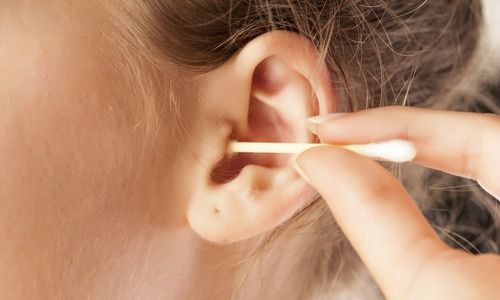Cotton Swabs Clean Your Ears Less Than You Think: Here's What Really Works

By now, if you haven’t seen it, you’ve definitely read about the accident Lena Dunham’s character on HBO’s Girls had with a cotton swab. Intense, deep swabbing left a cotton swab lodged in her ear, and she needed to enlist the help of a doctor.
Granted, this is an exaggerated exception to the rule. But over the years, cotton swabs, like Q-tips, have gotten the short end of the stick when it comes to ear health. What once was a convenient way to get rid of ear wax (scientifically know as cerumen) is now believed to hurt more than help.
What’s so bad about ear wax anyway? And how does anyone clean their ears without a cotton swab? We’re glad you asked.
Can You Hear Me Now?
Cotton swabs are primarily used to remove ear wax. Only ear wax is what promotes ear health.
“Ear wax has antibacterial and antifungal properties. It keeps the ear canal skin protected from getting too dry and is a natural cleaner of the ear canal,” Dr. Jeffrey Spiegel, a professor in the department of otolaryngology at Boston University School of Medicine, told Medical Daily in an email.
The amount of ear wax, as well as the color and the consistency (soft versus hard) varies person to person, Dr. Ronald Hoffman, medical director of the Ear Institute at New York Eye and Ear Infirmary of Mount Sinai, told Medical Daily in an email.
Ear wax naturally migrates to, and naturally leaves, the outer edge of the ear. Anything that prevents the wax from moving out — like, say, constantly walking around with headphones in — can result in build-up.
A 2008 JAMA study found ear wax build-up results in 12 million patient visits per year. Beyond headphones, excessive ear hair, narrow ear canals, and bony growths called exostoses lead to build-up, said Spiegel. The growths tend to occur in people who surf, and anyone swimming in cold water may stunt the wax migration process.
The Inner Circle
Obviously keeping build-up to a minimum is key. While cotton swabs are great for cleaning the outer ear, they pose real risk to the inner ear.
“The ear canal, which has very delicate skin, can be scratched by the swab and create a situation where one can get an ear infection,” Spiegel said. “You may feel it's working as some of the wax from the side of the canal sticks to the cotton and changes the cotton swab color from white to yellow. However, at the tip you've managed to just push the wax further in [the ear canal, where it’s difficult to get out].”
Hoffman added pushing cotton swabs too far into the ears damages the delicate structures of the middle and inner ear, which can cause permanent hearing loss (a health problem linked to cognitive impairment later in life), bleeding, and redness.
Clean Up, Clean Up
Surprisingly, the best way to clean ears is not to.
“Leave the ear canal alone and the wax will naturally move out,” Spiegel said. “If you are concerned, go see an otolaryngologist (head and neck surgeon). The surgeon will use a microscope and microsurgical instruments to comfortably remove the wax from your ears.”
Swimmer's ear is best prevented, Spiegel suggested, wearing wax earplugs and waterproof foam ear bands to keep water out of the ear. More severe cases should be seen by an otolaryngologist for antibiotic ear drops.
That said, there are alternative ways to maintain ear health. Hoffman mentioned there are over-the-counter wax dissolving drops, though he recommends speaking to a doctor before actually buying them. "If you have a hole in your eardrum and you put drops in to dissolve wax, you could cause an infection," Hoffman said. "Some people have very narrow ear canals and using the drops could actually make things worse."
Dr. Sean Hashmi, a practicing physician at Keiser Permanente in San Francisco, told Medical Daily in an e-mail he'll sometimes soften ear wax with liquid docusate, which is normally a stool softener.
There's also new products called OTO Tip (achieves basic cleaning) and the TEC Home (removes wax plugs) under a startup company called Clear Ear.
"The idea is that if you can clean your ears at home every so often, that will make the larger [ear wax] build-ups less likely," Clear Ear co-founder Lily Truong told TechCrunch. "I’ve previously seen people use really dangerous methods to clean out ear wax like safety pins, ear candling, and bobby pins."
The bottom line: Keeping wax build-up at bay isn't limited to a cotton swab, and it's definitely not fixed with a bobby pin. Yikes.
For more information, and resources to find specialists near you, visit the American Academy of Otolaryngology-Head And Neck Surgery's website.



























